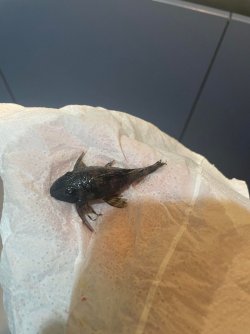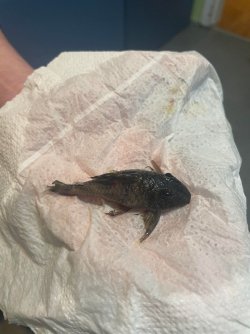It's been a while since I have posted here. All my tanks have been doing well and just pottering along.
Until this week. One of my L199s (Hypancistrus furunculus) looked a bit pale and off two days ago. But hard to see what was really going on because plecos hide, though these guys normally pop out at feeding time. We did a couple water changes. Today, I saw the fish, not hiding, and it looked terrible. Its tail and anal fins had completely deteriorated and its pec fins did not look good. It wriggled when I prodded it with a net, but barely. I promptly caught it. It had a lot of red around its anus and blood coming out. But no worms (or nothing that was obviously a worm). Then I PTS with clove oil because it was pretty far gone. Poor wee guy.
Tank is 125L. It has three L199s (four including the deceased one), some number of Corydoras habrosus, some pygmy cories (they breed... I have no idea how many are in there now), one lone Corydoras carlae, and four CW045 cories. I run three powerheads to make it as river-like as possible. I do a 70-ish% water change once per week. Tank has been running in this configuration for almost three years now. We have not added any new fish or plants in like a year. Everyone else in the tank that I can see looks fine, though I can't see much of the other three plecos.
Only change is that our fish have not been getting as much live food as they used to because life is complicated, and the best fish shop for buying it is a bit of a mission to get to. So we haven't gotten down there in a while.
All parameters are copacetic. Ammonia, nitrate, nitrite are all 0, which is normal. PH is 6.0, which is normal for us. Very soft water area.
Any ideas? Do I need to panic and treat the tank with something? Is it just one of those unlucky things?



Until this week. One of my L199s (Hypancistrus furunculus) looked a bit pale and off two days ago. But hard to see what was really going on because plecos hide, though these guys normally pop out at feeding time. We did a couple water changes. Today, I saw the fish, not hiding, and it looked terrible. Its tail and anal fins had completely deteriorated and its pec fins did not look good. It wriggled when I prodded it with a net, but barely. I promptly caught it. It had a lot of red around its anus and blood coming out. But no worms (or nothing that was obviously a worm). Then I PTS with clove oil because it was pretty far gone. Poor wee guy.
Tank is 125L. It has three L199s (four including the deceased one), some number of Corydoras habrosus, some pygmy cories (they breed... I have no idea how many are in there now), one lone Corydoras carlae, and four CW045 cories. I run three powerheads to make it as river-like as possible. I do a 70-ish% water change once per week. Tank has been running in this configuration for almost three years now. We have not added any new fish or plants in like a year. Everyone else in the tank that I can see looks fine, though I can't see much of the other three plecos.
Only change is that our fish have not been getting as much live food as they used to because life is complicated, and the best fish shop for buying it is a bit of a mission to get to. So we haven't gotten down there in a while.
All parameters are copacetic. Ammonia, nitrate, nitrite are all 0, which is normal. PH is 6.0, which is normal for us. Very soft water area.
Any ideas? Do I need to panic and treat the tank with something? Is it just one of those unlucky things?






